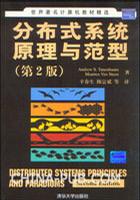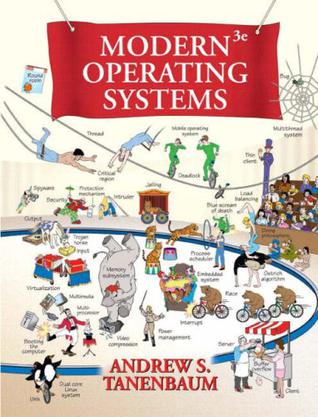欢迎来到相识电子书!
标签:Tanenbaum
-
分布式系统原理与范型
本书是著名作者Tanenbaum关于分布式系统的最新力作,是分布式系统的权威教材。本书分成了两大部分。第2~9章讨论的是分布式系统的的原理、概念和技术,包括通信、进程、命名、同步化、一致性和复制、容错性以及安全性等,而分布式应用的开发方法(即范型)在第10~13章中进行了讨论。但是,与前一版不同的是,我们没有在讨论范型的章节中完整地介绍每个案例研究,而是通过一个有代表性的案例来解释原理。这种介绍方法使得我们不仅精简了素材,而且可以使得读者在阅读和学习时更愉快些。全书结构清晰,内容全面经典,系统性与先进性并茂。 本书适用对象广泛,不仅可以作为学习分布式计算机的本科生和研究生的教材,对于从事分布式计算研究和工程应用的科技人员和工程技术人员来说,本书也是一本优秀的读物。 -
现代操作系统
本书是操作系统领域的经典之作,与第1版相比有较大的变化。书中集中讨论了操作系统的基本原理,除了重点放在单处理机操作系统之处,还包含了有关计算机安全、多媒体操作系统、UNIX、Window2000以及操作系统设计等方面的内容。书中涉及的主题包括图形用户界面、多处理机操作系统、笔记本电脑电源管理、可信系统、病毒、网络终端、CD-ROM文件系统、互斥信号量、RAID、软定时器、稳定存储器以及新的页面置换算法等。此外,书中还增加了大量习题,方便教学。 本书适合作为高等院校计算机科学与技术专业操作系统课程教材,也是设计、开发操作系统的重要参考书。 -
现代操作系统
《现代操作系统(英文版)(第2版)》内容包括:INTRODUCTION、PROCESSES AND THREADS、DEADLOCKS、MEMORY MANAGEMENT、INPUTIOUTPUT、FILE SYSTEMS、MULTIMEDIA OPERATING SYSTEMS、MULTIPLE PROCESSOR SYSTEMS、SECURITY、CASE STUDY 1: UNIX AND LINUX等。 -
计算机网络
《计算机网络》(第4版)是国内外使用最为广泛的计算机网络经典教材。全书按照网络协议模型(物理层、数据链路层、介质访问控制子层、网络层、传输层和应用层),自下而上系统地介绍了计算机网络的基本原理,并给出了大量实例。在讲述各网络层的同时,还融合进了近年来迅速发展起来的各种网络技术,如Internet、SONET、ADSL、CDMA、WLAN和蓝牙等。另外,针对当前计算机网络的发展现状以及计算机安全的重要性,《计算机网络》(第4版)用了一整间的篇幅对计算机安全进行了深入讨论。 -
计算机网络
本书是全球最具有权威性和经典性的计算机网络教材,我国各大专院校也广泛采用此书作为计算机网络课程的基本教材。作者Tanenbaum 教授以高深的理论造诣和丰富的实践经验,在书中对计算机网络的原理、结构、协议标准与应用等做了深入的分析与研究。 全书按照网络协议模型(物理层、数据链路层、介质访问控制子层、网络层、传输层和应用层),自底向上逐层讲述每一层所用的技术与协议标准,并给出大量实例。全书内容全面详实,体系清晰合理,叙述由简入繁、层层深入,自底向上方法也符合人类从底层到高层的认识规律,因此是公认的最适合网络入门的教材。 随着计算机网络的发展,本版对相关内容进行了大量修订、更新和补充,具体更新内容如下: •无线网络(802.12和802.16)。 •智能手机使用的3G网络。 •RFID和传感器网络。 •使用CDNs进行内容分发。 •对等网络。 •实时媒体。 •网络电话。 •延迟容忍网络。 -
Modern Operating Systems
For software development professionals and computer science students, Modern Operating Systems gives a solid conceptual overview of operating system design, including detailed case studies of Unix/Linux and Windows 2000. What makes an operating system modern? According to author Andrew Tanenbaum, it is the awareness of high-demand computer applications--primarily in the areas of multimedia, parallel and distributed computing, and security. The development of faster and more advanced hardware has driven progress in software, including enhancements to the operating system. It is one thing to run an old operating system on current hardware, and another to effectively leverage current hardware to best serve modern software applications. If you don't believe it, install Windows 3.0 on a modern PC and try surfing the Internet or burning a CD. Readers familiar with Tanenbaum's previous text, Operating Systems, know the author is a great proponent of simple design and hands-on experimentation. His earlier book came bundled with the source code for an operating system called Minux, a simple variant of Unix and the platform used by Linus Torvalds to develop Linux. Although this book does not come with any source code, he illustrates many of his points with code fragments (C, usually with Unix system calls). The first half of Modern Operating Systems focuses on traditional operating systems concepts: processes, deadlocks, memory management, I/O, and file systems. There is nothing groundbreaking in these early chapters, but all topics are well covered, each including sections on current research and a set of student problems. It is enlightening to read Tanenbaum's explanations of the design decisions made by past operating systems gurus, including his view that additional research on the problem of deadlocks is impractical except for "keeping otherwise unemployed graph theorists off the streets." It is the second half of the book that differentiates itself from older operating systems texts. Here, each chapter describes an element of what constitutes a modern operating system--awareness of multimedia applications, multiple processors, computer networks, and a high level of security. The chapter on multimedia functionality focuses on such features as handling massive files and providing video-on-demand. Included in the discussion on multiprocessor platforms are clustered computers and distributed computing. Finally, the importance of security is discussed--a lively enumeration of the scores of ways operating systems can be vulnerable to attack, from password security to computer viruses and Internet worms. Included at the end of the book are case studies of two popular operating systems: Unix/Linux and Windows 2000. There is a bias toward the Unix/Linux approach, not surprising given the author's experience and academic bent, but this bias does not detract from Tanenbaum's analysis. Both operating systems are dissected, describing how each implements processes, file systems, memory management, and other operating system fundamentals. Tanenbaum's mantra is simple, accessible operating system design. Given that modern operating systems have extensive features, he is forced to reconcile physical size with simplicity. Toward this end, he makes frequent references to the Frederick Brooks classic The Mythical Man-Month for wisdom on managing large, complex software development projects. He finds both Windows 2000 and Unix/Linux guilty of being too complicated--with a particular skewering of Windows 2000 and its "mammoth Win32 API." A primary culprit is the attempt to make operating systems more "user-friendly," which Tanenbaum views as an excuse for bloated code. The solution is to have smart people, the smallest possible team, and well-defined interactions between various operating systems components. Future operating system design will benefit if the advice in this book is taken to heart. --Pete Ostenson --This text refers to the Hardcover edition. Product Description The widely anticipated revision of this worldwide best-seller incorporates the latest developments in operating systems technologies. The Third Edition includes up-to-date materials on relevant operating systems such as Linux, Windows, and embedded real-time and multimedia systems. Includes new and updated coverage of multimedia operating systems, multiprocessors, virtual machines, and antivirus software. Covers internal workings of Windows Vista (Ch. 11); unique even for current publications. Provides information on current research based Tanenbaum’s experiences as an operating systems researcher. A useful reference for programmers.
热门标签
下载排行榜
- 1 梦的解析:最佳译本
- 2 李鸿章全传
- 3 淡定的智慧
- 4 心理操控术
- 5 哈佛口才课
- 6 俗世奇人
- 7 日瓦戈医生
- 8 笑死你的逻辑学
- 9 历史老师没教过的历史
- 10 1分钟和陌生人成为朋友






